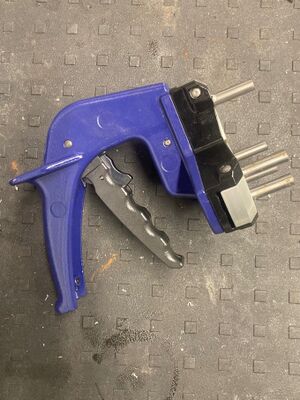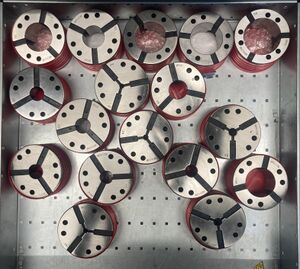Klamp DKF65A6
A collet chuck is incredibly easy to use - simply insert the appropriate sized collet, insert your material, and clamp on it. Concentricity is almost guaranteed. The downside is that the clamping range of each collet is limited - plus or minus 0.5mm for our collets. For example, a collet marked 12mm will hold stock sized between 11.5 and 12.5 mm.
When selecting stock take into consideration that the majority of bar material produced in and imported into the UK will be imperial sized. This is why we have a 13mm collet - to hold half inch (12.7 mm) bar stock.
Our model of collet chuck (Klamp DKF65A6) has a maximum clamping capacity of 65mm, which is also the maximum spindle bore capacity of the lathe. If you need to clamp on material that is larger than 65mm in diameter you will need to mount the 3-jaw chuck. The chuck is a "dead length" design, meaning that the amount of material sticking out of the face won't change between when you clamp and unclamp.
Collets are an expensive piece of precision equipment, costing £170+VAT each. Take special care to not scratch any of the taper surfaces or inside the bore. Don't force an over-size piece of material into a collet, and ensure the collet has sufficient grip to hold on to your work at high RPMs. Please don't drop the collets, and clean them well before and after use.
Changing collets

Inserting and removing collets is done with a special quick-change gun. The gun is inserted into the holes on the face of the collet and the trigger is pulled to compress the collet. The chuck is unclamped with the foot pedal and the collet can be removed and placed in its protective storage housing. Once you have removed the collet, make sure you clean it and the taper of the collet chuck very well.
Removing a collet
- Move the tool turret to the home position so there is enough space to work safely.
- Unclamp the chuck and remove any material from the machine completely.
- Insert the quick-change tool into the face of the collet.
- Squeeze the trigger handle of the quick-change tool to compress the collet. Keep pulling until it has latched in the compressed position.
- Pull the collet straight out of the chuck.
- Hold the compressed collet just above the rubber-covered work top and pull the smaller trigger to release it.
- Clean the collet thoroughly with a paper towel and WD-40.
- Press the Emergency stop to disable the chuck foot switch.
- Clean the inside of the chuck thoroughly with a paper towel and WD-40. Make sure there are no chips caught inside the collet.
- Release the Emergency stop and press the Reset button.
Inserting a collet
- Move the tool turret to the home position so there is enough space to work safely.
- Unclamp the chuck and ensure there is no material in the spindle or spindle liner.
- Check that the chuck is exceptionally clean and free of chips and dirt.
- Check that the collet you wish to use is exceptionally clean and free of chips and dirt. Clean it with WD-40 if required.
- Insert the quick-change tool into the face of the collet you wish to use.
- Squeeze the trigger hangle of the quick-change tool to compress the collet. Keep pulling until it has latched in the compressed position.
- Line up the notches on the outer surface of the collet with the three pegs on the interior of the chuck.
- Push the collet straight back until it is seated securely in the chuck.
- Pull the small trigger on the quick-change tool to release the chuck. Remove the tool from the collet face.
- Test the chuck actuation with the foot pedal.
Collet Storage

Collets are stored in the second drawer of the wheeled tool cabinet opposite the lathe. They should be replaced - cleaned - in the drawer after they have been used. A light coat of WD-40 before putting a collet away will help keep them in good condition for longer. Collets we keep on hand (mm):
6, 6 Hex, 7, 12, 13, 20, 22, 24, 25, 26, 32, 38, 50, 51, 56, 57, 65
If you need a particular size collet to complete a project please ask a member of technical staff - we can look into getting hold of the correct size for you. Collets are DC65 size.
